Surinam cherry, Pitanga
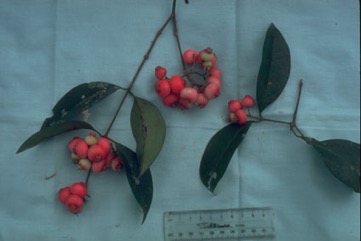
It is a tropical plant. It grows in the lowlands. It is native to South America. It grows in the tropical lowlands from sea level up to about 800 m or higher in Papua New Guinea. In south India it grows to 1700 m altitude. In Argentina it grows from sea level to 1,500 m above sea level. It is suited to a warm moist climate. Adequate moisture is needed during fruit development. It can be grown in the subtropics. It can stand some frost. Mature trees can withstand frosts down to -3°C. It does best with a pH of 5-7. It grows in Miombo woodland in Africa. It suits hardiness zones 10-12. In XTBG Yunnan. In Sichuan.
Also known as:
Badirbonga, Brazilian cherry, Cayenne cherry, Ceremai belanda, Cereza de cayena, Cereza de Surinam, Ceri brazil, Cerise de cayenne, Dewandaru, Dorobokalatrano, Florida cherry, Guinda, Hong zi guo, Mayom-farang, Pendanga, Pitanga de praia, Rasay, Surinaamsekers, Teri
Synonyms
- Eugenia michelii Lamk.
- Luma costata (Cambess.) Herter
- Myrtus brasiliana L.
- Plinia rubra L.
- Stenocalyx michelii (Lam.) O. Berg
- Syzygium michelii (Lam.) Duthie
- and several others
Edible Portion
- Fruit, Leaves - tea
Where does Surinam cherry grow?
Found in: Africa, Amazon, Argentina, Asia, Australia, Bahamas, Belize, Bermuda, Brazil, Cameroon, Central Africa, Central America, China, Colombia, Cook Islands, Cuba, Dominican Republic, East Africa, El Salvador, Ethiopia, Fiji, French Guiana, Ghana, Guadeloupe, Guatemala, Guianas, Guinea-Bissau, Guyana, Haiti, Hawaii, India, Indochina, Indonesia, Jamaica, Japan, Madagascar, Malawi, Malaysia, Marquesas, Martinique, Mexico, Micronesia, Mozambique, Norfolk Island, Pacific, Panama, Papua New Guinea, PNG, Paraguay, Philippines, Pohnpei, Puerto Rico, Samoa, Sao Tome and Principe, SE Asia, Sierra Leone, South America, Sri Lanka, St Lucia, Suriname, Taiwan, Thailand, Tonga, Uganda, Uruguay, United States, Vanuatu, Venezuela, Vietnam, West Africa, West Indies, Zambia, Zimbabwe
Notes: There are about 550 Eugenia species. They are mostly in tropical and subtropical South America. It has antioxidant activities.
Status: Trees have been grown and distributed in some coastal areas in Papua New Guinea.
Growing Surinam cherry, Pitanga
Cultivation: Trees are mostly grown from seeds but can be grown from cuttings. Seeds should be fresh. Seeds grow in 3-5 weeks. Seed which are extracted from the fruit then washed and dried can be stored for a month. Seed can be sun dried for 7 days then stored in cool open containers for a few months. Seed can be planted 1-2 cm deep in nursery beds than transplanted when 20-30 cm tall. Trees can be trimmed and pruned to form hedges. Ground layering and suckers could probably be used to produce new plants. Tips from trees with better fruit types can be grafted onto seedling root stocks. It can be trained as a hedge.
Edible Uses: The ripe fruit is eaten fresh. It can be cooked or used for jams and other products. The leaves are used as a substitute for tea.
Production: It is a slow growing plant. Several crops of fruit are produced each year. Flowers or fruit can be on the tree throughout the year in tropical locations. Trees start to produce fruit after about 3-4 years. Fruit are mature 5-6 weeks after flowering.
Nutrition Info
per 100g edible portion| Edible Part | Energy (kcal) | Protein (g) | Iron (mg) | Vitamin A (ug) | Vitamin c (mg) | Zinc (mg) | % Water |
|---|---|---|---|---|---|---|---|
| Fruit | 33 | 0.8 | 0.2 | 150 | 26.3 | - | 90.8 |
Surinam cherry, Pitanga Photos

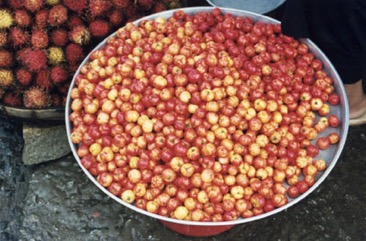
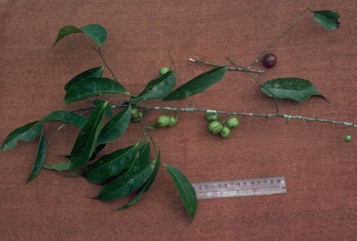
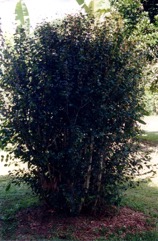
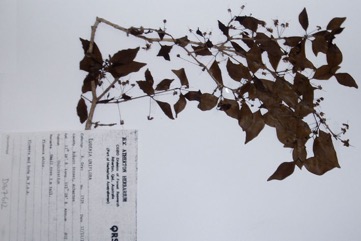
References
Surinam cherry references
Abbiw, D.K., 1990, Useful Plants of Ghana. West African uses of wild and cultivated plants. Intermediate Technology Publications and the Royal Botanic Gardens, Kew. p 46
Ambasta, S.P. (Ed.), 2000, The Useful Plants of India. CSIR India. p 211
Arora, R. K., 2014, Diversity in Underutilized Plant Species - An Asia-Pacific Perspective. Bioversity International. p 70
Asfaw, Z. and Tadesse, M., 2001, Prospects for Sustainable Use and Development of Wild Food Plants in Ethiopia. Economic Botany, Vol. 55, No. 1, pp. 47-62
Bailao, E. F. L. C., et al, 2015, Bioactive Compounds Found in Brazilian Cerrado Fruits. International Journal of Molecular Sciences. 16:23760-23783
Barwick, M., 2004, Tropical and Subtropical Trees. A Worldwide Encyclopedic Guide. Thames and Hudson p 174
Berihun, T. & Molla, E., 2017, Study on the Diversity and Use of Wild Edible Plants in Bullen District Northwest Ethiopia. Hindawi Journal of Botany. Article ID 8383468
Bianchini, F., Corbetta, F., and Pistoia, M., 1975, Fruits of the Earth. Cassell. p 168
Bodkin, F., 1991, Encyclopedia Botanica. Cornstalk publishing, p 459
Bortolotto, I. M., et al, 2015, Knowledge and use of wild edible plants in rural communities along Paraguay River, Pantanal, Brazil. Journal or Ethnobiology and Ethnomedicine. 11:46
Bortolotto, I. M., et al, 2018, Lista preliminar das plantas alimenticias nativas de Mato Grosso do Sul, Brasil. Iheringia, Serie Botanica, Porto Alegre, 73 (supl.):101-116
Brazil: Biodiversity for Food and Nutrition. http://www.b4fn.org/countries/brazil/
Burkill, H. M., 1985, The useful plants of west tropical Africa, Vol. 4. Kew.
Burkill, I.H., 1935, A Dictionary of the Economic Products of the Malay Peninsula. p 987
Coradin, L. et al (Eds), 2011, Especies Nativas da Flora Brasileira de Valor Economico Atual ou Potencial. Brasilia MMA. p 170
Coronel, R.E., 1982, Fruit Collections in the Philippines. IBPGR Newsletter p 6
Cundall, P., (ed.), 2004, Gardening Australia: flora: the gardener's bible. ABC Books. p 579
Darley, J.J., 1993, Know and Enjoy Tropical Fruit. P & S Publishers. p 129
Facciola, S., 1998, Cornucopia 2: a Source Book of Edible Plants. Kampong Publications, p 158
Flora of Australia Volume 49, Oceanic Islands 1, Australian Government Publishing Service, Canberra. (1994) p 217
French, B.R., 1986, Food Plants of Papua New Guinea, A Compendium. Asia Pacific Science Foundation p 244
Garner, R.J., and Chaudhri, S.A., (Ed.) 1976, The Propagation of Tropical fruit Trees. FAO/CAB. p 355
Gouldstone, S., 1983, Growing your own Food-bearing Plants in Australia. Macmillan p 122
Grandtner, M. M. & Chevrette, J., 2013, Dictionary of Trees, Volume 2: South America: Nomenclature, Taxonomy and Ecology. Academic Press p 243
Hearne, D.A., & Rance, S.J., 1975, Trees for Darwin and Northern Australia. AGPS, Canberra p 66
Hedrick, U.P., 1919, (Ed.), Sturtevant's edible plants of the world. p 302
Hermandez Bermejo, J.E., and Leon, J. (Eds.), 1994, Neglected Crops. 1492 from a different perspective. FAO Plant Production and Protection Series No 26. FAO, Rome. p 16
Hibbert, M., 2002, The Aussie Plant Finder 2002, Florilegium. p 99
Howard, R., 1974-. Flora of the lesser Antilles.
Hu, Shiu-ying, 2005, Food Plants of China. The Chinese University Press. p 576
Hunter, D., et al, 2019, The potential of neglected and underutilized species for improving diets and nutrition. Planta (2019) 250:709-729
Huxley, ed. The new Royal Horticultural Society dictionary of gardening. 1992
INFOODS:FAO/INFOODS Databases
International Seed Testing Association. 1988. International Seed Testing Association list of stabilized plant names. (ISTA)
Jardin, C., 1970, List of Foods Used In Africa, FAO Nutrition Information Document Series No 2.p 135
John, L., & Stevenson, V., 1979, The Complete Book of Fruit. Angus & Robertson p 160
Katende, A.B., Birnie, A & Tengnas B., 1995, Useful Trees and Shrubs for Uganda. Identification, Propagation and Management for Agricultural and Pastoral Communities. Technical handbook No 10. Regional Soil Conservation Unit, Nairobi, Kenya. p 294
Kinupp, V. F., 2007, Plantas alimenticias nao-convencionais da regiao metropolitana de Porto Alegre, RS, Brazil p 86
Kiple, K.F. & Ornelas, K.C., (eds), 2000, The Cambridge World History of Food. CUP p 1836
Kujawska, M. & Luczaj, L., 2015, Wild Edible Plants Used by the Polish Community in Misiones, Argentina. Human Ecology 43:855-869
Lembaga Biologi Nasional, 1977, Buah-Buahan, Balai Pustaka, Jakarta. p 14
Leon, J., 1968, Fundamentos Botanicos de Los Cultivos Tropicales p 399
Little, E. L., et al, 1974, Trees of Puerto Rico and the Virgin Islands. USDA Handbook 449. Forestry Service. p 662
Llamas, K.A., 2003, Tropical Flowering Plants. Timber Press. p 285
Lord, E.E., & Willis, J.H., 1999, Shrubs and Trees for Australian gardens. Lothian. p 55
Lorenzi, H., 2002, Brazilian Trees. A Guide to the Identification and Cultivation of Brazilian Native Trees. Vol. 01 Nova Odessa, SP, Instituto Plantarum p 278
Lorenzi, H., Bacher, L., Lacerda, M. & Sartori, S., 2006, Brazilian Fruits & Cultivated Exotics. Sao Paulo, Instituto Plantarum de Estuados da Flora Ltda. p 214
Lyle, S., 2006, Discovering fruit and nuts. Land Links. p 198
Macmillan, H.F. (Revised Barlow, H.S., et al) 1991, Tropical Planting and Gardening. Sixth edition. Malayan Nature Society. Kuala Lumpur. p 299
Martin, F. W., et al, 1987, Perennial Edible Fruits of the Tropics. USDA Handbook 642 p 40
Mello, A. J. M., 2015, Cultural landscapes of the Araucaria Forests in the northern plateau of Santa Catarina, Brazil. Journal of Ethnobiology and Ethnomedicine 11:51
Miguel, E., et al, 1989, A checklist of the cultivated plants of Cuba. Kulturpflanze 37. 1989, 211-357
Morton, Julia F., 1987, Fruits of Warm Climates. Creative Resources Systems, Inc. . p. 386
Norrington, L., & Campbell, C., 2001, Tropical Food Gardens. Bloomings Books. p 96
NYBG herbarium "edible"
Oliviera V. B., et al, 2012, Native foods from Brazilian biodiversity as a source of bioactive compounds. Food Research International 48 (2012) 170-179
Omawale, 1973, Guyana's edible plants. Guyana University, Georgetown p 49
Paz, F. S., et al, 2021, Edible Fruit Plant Species in the Amazon Forest Rely Mostly on Bees and Beetles as Pollinators. Journal of Economic Entomology, XX(XX), 2021, 1–13
Peekel, P.G., 1984, (Translation E.E.Henty), Flora of the Bismarck Archipelago for Naturalists, Division of Botany, Lae, PNG. p 408, 406
Plants of Haiti Smithsonian Institute http://botany.si.edu/antilles/West Indies
Poponoe,W., 1920, Manual of Tropical and Subtropical Fruits. Macmillan. p 286-292.
Priyadi, H., et al, Five hundred plant species in Gunung Halimun Salak National Park West Java. A checklist including Sundanese names, distribution and use. CIFOR, FFPRI, SLU p 35
PROSEA (Plant Resources of South East Asia) handbook, Volume 2, 1991, Edible fruits and nut. p 165
Purseglove, J.W., 1968, Tropical Crops Dicotyledons, Longmans. p 401
Recher, P, 2001, Fruit Spirit Botanical Gardens Plant Index. www.nrg.com.au/~recher/ seedlist.html p 2
Reitz, ed. 1965-. Flora ilustrada catarinense.
Riley, J.M., 1971, Pitanga: Surinam cherry. Californian Rare Fruit Council Year Book 1971. p14-25.
Riley, J.M., 1973, Growing Rare Fruit in Northern California. Californian Rare Fruit Council Year Book 1973. pp 67-90.
Scarpa, G. F., 2009, Wild food plants used by the indigenous peoples of South American Gran Chaco: A general synopsis and intercultural comparison. Journal of Applied Botany and Food Quality 83:90-101
Segura, S., et al, 2018, The edible fruit species in Mexico. Genet Resour Crop Evol (2018) 65:1767–1793
Sp. pl. 1:470. 1753
Staples, G.W. and Herbst, D.R., 2005, A tropical Garden Flora. Bishop Museum Press, Honolulu, Hawaii. p 423 (Drawing)
Sukarya, D. G., (Ed.) 2013, 3,500 Plant Species of the Botanic Gardens of Indonesia. LIPI p 626
Tankard, G., 1990, Tropical fruit. An Australian Guide to Growing and using exotic fruit. Viking p 106
Terrell et al. 1986. Agric. Handb. no. 505.
USDA, ARS, National Genetic Resources Program. Germplasm Resources Information Network - (GRIN). [Online Database] National Germplasm Resources Laboratory, Beltsville, Maryland. Available: www.ars-grin.gov/cgi-bin/npgs/html/econ.pl (10 April 2000)
van Wyk, B., 2005, Food Plants of the World. An illustrated guide. Timber press. p 192
Verheij, E. W. M. and R. E. Coronel, eds. 1991. Edible fruits and nuts. In: E. W. M. Verheij & R. E. Coronel (eds.), Plant Resources of South-East Asia (PROSEA). 2:165.
Villachica, H., (Ed.), 1996, Frutales Y hortalizas promisorios de la Amazonia. FAO, Lima. p 229
Vivien, J., & Faure, J.J., 1996, Fruitiers Sauvages d'Afrique. Especes du Cameroun. CTA p 235
Williams, C.N., Chew, W.Y., and Rajaratnam, J.A., 1989, Tree and Field Crops of the Wetter Regions of the Tropics. Longman, p 140.
World Checklist of Useful Plant Species 2020. Royal Botanic Gardens, Kew
www.colecionandofrutas.org
www.worldagroforestrycentre.org/sea/products/afdbases/af/asp/SpeciesInfo.asp?SpID=18082
Zawiah, N. & Othaman, H., 2012, 99 Spesies Buah di FRIM. Institut Penyelidikan Perhutanan Malaysia. p 230 (As Syzygium uniflora)